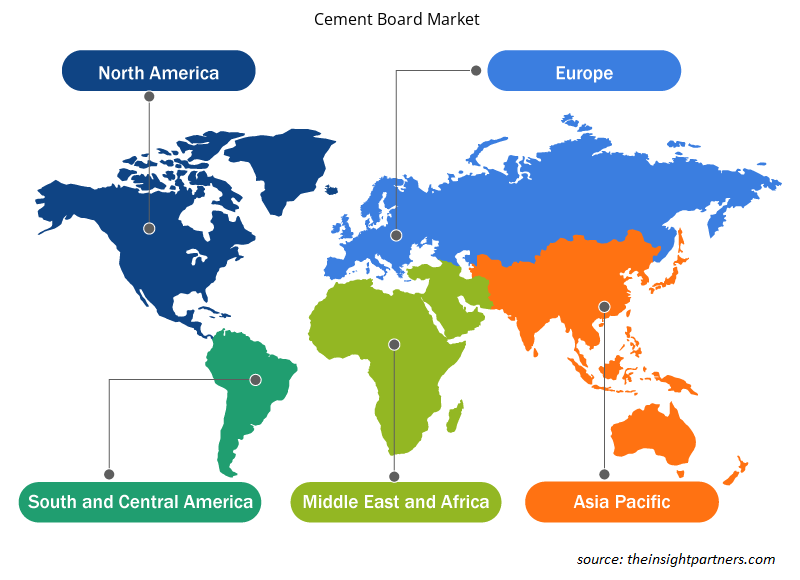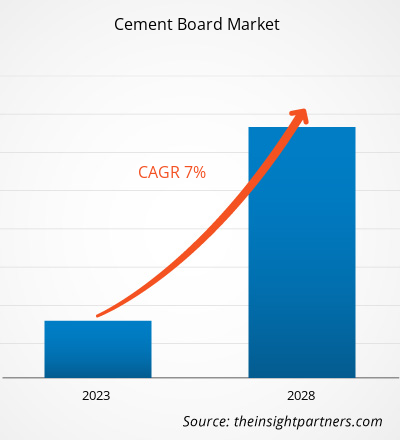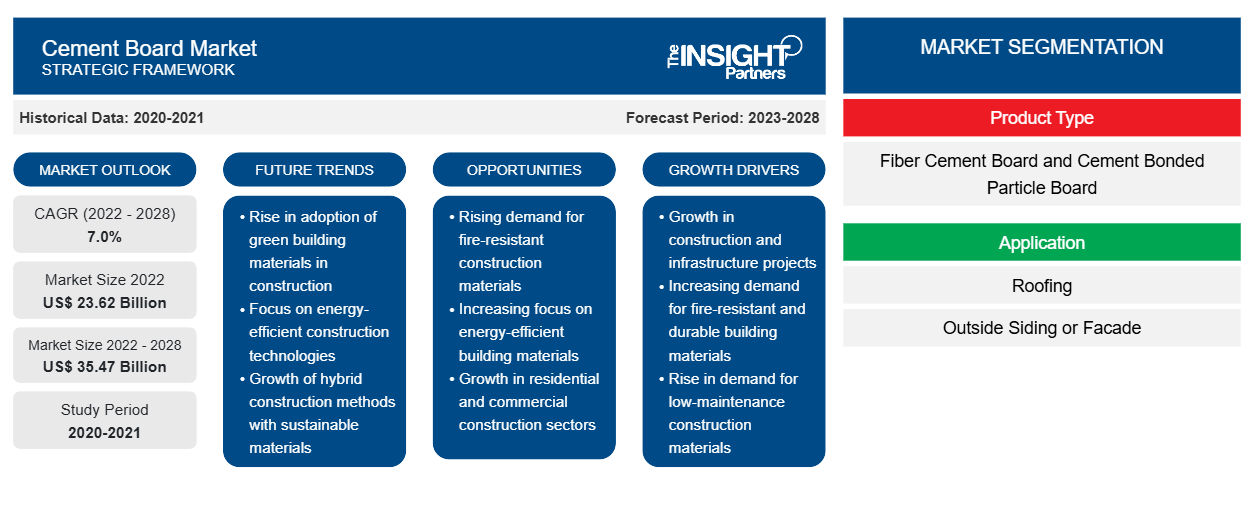[調査レポート] セメントボード市場規模は、2022年の236億1,663万米ドルから2028年には354億7,356万米ドルに成長すると予想されており、2022年から2028年にかけて7.0%のCAGRを記録すると予測されています。
市場分析
セメントボードは、セメント、ガラス、骨材、繊維強化材を組み合わせたもので、シート状に成形され、タイルの裏板として、また壁や床の建造に使用されます。セメントボードには、繊維セメントボードやセメント結合パーティクルボードなど、さまざまな製品タイプがあります。セメント結合パーティクルボードは、剛性、耐火性、大気物質に対する耐性、遮音性に優れています。主に、床材、ファサード、壁装材、門扉、その他の建設製品に使用されています。セメントボードは、不燃性、耐水性、耐紫外線性、腐食や巻き付きに対する耐性など、優れた物理的特性を備えているため、さまざまな建設活動に使用されています。
成長の原動力と課題
建設部門におけるセメントボードの採用の増加により、世界のセメントボード市場の成長が大幅に促進されています。耐久性は、セメントボードの最も望ましい特性の 1 つです。セメントボードとパネルは、通常、ビニール サイディングやその他の代替製品よりも寿命が長くなります。10 ~ 15 年以内に、ビニール サイディングは劣化の兆候を示すことがありますが、セメントボードは 30 ~ 50 年以上持続します。さらに、セメントの製造では、二酸化炭素が副産物として発生します。ただし、ポリ塩化ビニル (PVC) を含むビニール サイディングの製造では、セメントの製造よりも多くの二酸化炭素が発生します。さらに、ビニール サイディングは、埋め立て地のスペースを占有するため、その寿命全体にわたってガスを放出します。さらに、エネルギー効率の高い建物の需要の急増により、世界のセメントボード市場の成長がさらに促進されています。発展途上国の都市の近代化と 1 人あたりの所得の増加により、世界中の建物でのエネルギー使用が促進されています。公共、住宅、商業ビルでのエネルギー消費量が多いため、エネルギーを節約する必要があります。国際エネルギー機関によると、2035 年までに世界のエネルギー節約潜在量の約 41% を建物が占めると予想されており、産業部門と輸送部門はそれぞれ 24% と 21% を占めることになります。建物にセメント ボードの層を塗布すると、壁を通じた熱伝達が減少し、冬は室内を暖かく、夏は涼しく保つことができ、建物のエネルギー効率が向上します。ただし、セメント ボードの購入と設置にかかるコストが高いため、市場の成長が制限される可能性があります。
要件に合わせてレポートをカスタマイズする
このレポートの一部、国レベルの分析、Excelデータパックなど、あらゆるレポートを無料でカスタマイズできます。また、スタートアップや大学向けのお得なオファーや割引もご利用いただけます。
- このレポートの主要な市場動向を入手してください。この無料サンプルには、市場動向から見積もりや予測に至るまでのデータ分析が含まれます。
レポートのセグメンテーションと範囲
「2030 年までの世界のセメントボード市場分析」は、世界のセメントボード市場の動向と成長機会に重点を置いた専門的で詳細な調査です。このレポートは、製品タイプ、用途、最終用途、および地域別の詳細な市場区分とともに、世界のセメントボード市場の概要を提供することを目的としています。世界のセメントボード市場は、最近高い成長を遂げており、予測期間中もこの傾向が続くと予想されています。このレポートでは、主要な地域と国での需要とともに、世界中のセメントボードの消費に関する主要な統計を提供します。さらに、レポートでは、主要な地域と国でのセメントボード市場のパフォーマンスに影響を与えるさまざまな要因の定性的な評価を提供します。レポートには、セメントボード市場の主要プレーヤーとその主要な戦略的展開に関する包括的な分析も含まれています。また、主要な推進要因、市場動向、および収益性の高いセメントボード市場の機会を特定するために、市場ダイナミクスに関するいくつかの分析も含まれており、主要な収益源を特定するのに役立ちます。
さらに、エコシステム分析とポーターの 5 つの力の分析により、世界のセメントボード市場の 360 度の視点が得られ、サプライ チェーン全体と市場の成長に影響を与えるさまざまな要因を理解するのに役立ちます。
セグメント分析
世界のセメントボード市場は、製品タイプ、用途、最終用途に基づいてセグメント化されています。製品タイプに基づいて、セメントボード市場は、繊維セメントボードとセメント結合パーティクルボードに分類されます。用途に基づいて、市場は屋根材、外壁またはファサード、その他に分類されます。
最終用途に基づいて、市場は住宅用と非住宅用に分かれています。製品タイプに基づいて、繊維セメントボードセグメントは、セメントボードの大きな市場シェアを占めています。これは、建設セクターでのセメントボードの採用の増加に起因する可能性があります。繊維セメントボードは、耐久性と耐火性、湿気、昆虫に対する耐性により、多用途で人気のある建築材料です。セメント、砂、セルロース繊維、水で構成されるこのボードは、住宅および商業建設プロジェクトのサイディング、屋根、床、内壁によく使用されます。繊維セメントボードは軽量で作業が簡単です。そのため、ビルダーや請負業者に好まれています。用途に基づいて、外部サイディングまたはファサードが主要な市場を占めています。繊維セメントサイディングまたはファサードは、金属、従来の木材、ビニールサイディングまたはファサードの代替品として使用できます。サイディングまたはファサードは、さまざまなテクスチャ、色、サイズ、および形状で利用できるため、建築家やビルダーはユニークで視覚的に魅力的なデザインを作成できます。セメントボードは、耐久性、耐候性、腐敗、カビ、害虫への耐性などの主要な利点を提供します。最終用途に基づくと、住宅部門が世界のセメントボード市場で大きなシェアを占めています。住宅建設の需要は、人口増加により推進されています。繊維セメントボードとセメント結合パーティクルボードは、耐水性やシロアリ防止などの主要な利点により、住宅建設で広く使用されています。さらに、外国人人口の増加による急速な都市化と、二酸化炭素排出量の少ない環境に優しい住宅の需要の高まりにより、予測期間中に住宅部門のセメントボード市場の成長が促進されます。これにより、業界全体の成長のための新たな成長機会がさらに引き寄せられます。
地域分析
このレポートは、北米、ヨーロッパ、アジア太平洋(APAC)、中東およびアフリカ(MEA)、中南米の5つの主要地域に関する世界のセメントボード市場の詳細な概要を示しています。中東およびアフリカは市場の大きなシェアを占め、2022年には20億米ドルを超える価値があり、2030年には約30億米ドルに達すると推定されています。特に中東での建設活動の急速な増加は、中東およびアフリカの市場成長にプラスの影響を与えました。アジア太平洋地域も、この地域でのエネルギー効率の高い建物の需要の増加が世界のセメントボード市場の成長を牽引しているため、2022年には80億米ドルを超える大幅な成長が見込まれています。北米も、木材ボードよりも繊維セメントボードの好みが高まっているため、2022年には40億米ドルを超える大幅な成長が見込まれ、世界のセメントボード市場の成長を後押しすると予想されています。
業界の発展と将来の機会
パートナーシップ、買収、新製品の発売は、世界のセメントボード市場で活動する企業が採用している主要な戦略であることがわかりました。
- 2023年1月、James Hardie Building Productsは、Boise Cascade Companyとの新しい販売提携を発表しました。
- 2020 年 1 月、James Hardie Building Products は、ラスベガスで開催された The International Surface Event (TISE) で、HydroDefense テクノロジーを搭載した HardieBacker セメント ボードを展示しました。
セメントボード市場の地域別分析
予測期間を通じてセメントボード市場に影響を与える地域的な傾向と要因は、Insight Partners のアナリストによって徹底的に説明されています。このセクションでは、北米、ヨーロッパ、アジア太平洋、中東、アフリカ、南米、中米にわたるセメントボード市場のセグメントと地理についても説明します。

- セメントボード市場の地域別データを入手
セメントボード市場レポートの範囲
| レポート属性 | 詳細 |
|---|---|
| 2022年の市場規模 | 236.2億米ドル |
| 2028年までの市場規模 | 354.7億米ドル |
| 世界のCAGR(2022年 - 2028年) | 7.0% |
| 履歴データ | 2020-2021 |
| 予測期間 | 2023-2028 |
| 対象セグメント | 製品タイプ別
|
| 対象地域と国 | 北米
|
| 市場リーダーと主要企業プロフィール |
|
セメントボード市場のプレーヤー密度:ビジネスダイナミクスへの影響を理解する
セメントボード市場は、消費者の嗜好の変化、技術の進歩、製品の利点に対する認識の高まりなどの要因により、エンドユーザーの需要が高まり、急速に成長しています。需要が高まるにつれて、企業は提供を拡大し、消費者のニーズを満たすために革新し、新たなトレンドを活用し、市場の成長をさらに促進しています。
市場プレーヤー密度とは、特定の市場または業界内で活動している企業または会社の分布を指します。これは、特定の市場スペースに、その市場規模または総市場価値に対してどれだけの競合相手 (市場プレーヤー) が存在するかを示します。
セメントボード市場で事業を展開している主要企業は次のとおりです。
- ジェームス・ハーディ・インダストリーズ
- プライセムUSA LLC
- エベレスト インダストリーズ
- スイスパールグループAG
- ヴィサカ インダストリーズ
免責事項:上記の企業は、特定の順序でランク付けされていません。

- セメントボード市場のトップキープレーヤーの概要を入手
COVIDの影響/地政学的シナリオの影響/景気後退の影響
COVID-19パンデミックは、世界中の多くの産業の発展を低下させました。世界中の製造工場の閉鎖と貿易の制限により、世界中の製造業者のサプライチェーンが制約されました。COVID-19パンデミックは、化学および材料セクターとセメントボード市場の成長に悪影響を及ぼしました。SARS-CoV-2の拡散防止策の実施は、さまざまな産業の成長に悪影響を及ぼしました。包装、消費財、自動車および輸送、繊維、建築および建設などの産業は、国境と国際境界の突然の閉鎖による運用効率とバリューチェーンの突然の混乱により悪影響を受けました。COVID-19パンデミックの間、収益の減少とプロジェクトデリバリーの課題の増加により、ほとんどの市場でセクターが縮小し、労働力にそれに応じた悪影響がありました。多くの工場が長期間閉鎖されたため、建設業者は輸入原材料とオフサイト建築資材の遅延とコスト増加を経験しました。建築および建設業界へのダメージは、セメントボードの需要を妨げました。そのため、セメントボード市場はパンデミックの影響からかなり回復しており、今後数年間で成長すると予想されています。
競争環境と主要企業
セメントボード市場で活動している主要企業には、James Hardie Industries plc、Plycem USA LLC、Everest Industries Ltd、Swisspearl Group AG、Visaka Industries Ltd、Nichiha Corp、Soben International Ltd、SCG Building Materials Co., Ltd、Etex NV、Compagnie de Saint Gobain SA などがあります。
- 過去2年間の分析、基準年、CAGRによる予測(7年間)
- PEST分析とSWOT分析
- 市場規模価値/数量 - 世界、地域、国
- 業界と競争環境
- Excel データセット
最新レポート
お客様の声
購入理由
- 情報に基づいた意思決定
- 市場動向の理解
- 競合分析
- 顧客インサイト
- 市場予測
- リスク軽減
- 戦略計画
- 投資の正当性
- 新興市場の特定
- マーケティング戦略の強化
- 業務効率の向上
- 規制動向への対応





















 無料サンプルを入手 - セメントボード市場
無料サンプルを入手 - セメントボード市場